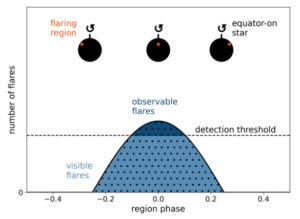Paper on AU Mic and planet-triggered flares

One possible manifestation of (magnetic) star-planet interactions is flare triggering by a planet passing by some active region of the star and disturbing the magnetic field structure of the active region enough that a flare is triggered earlier than it usually would have occurred. My PhD student Ekaterina Ilin recently studied the many TESS-observed flares of the young planet-hosting star AU Mic to test whether there is any significant correlation of flare timing with the orbit of the exoplanet or the synodic period. While there is some possible periodicity of larger flares with the planet’s orbital period, the effect is not significant at 3 sigma level. Should the effect be real and not a statistical fluctuation, an increased observing time by a factor of 2-3 should yield a solid detection!
Searching for flaring star-planet interactions in AU Mic TESS observations
Ilin, Ekaterina; Poppenhäger, Katja
Planets that closely orbit magnetically active stars are thought to be able to interact with their magnetic fields in a way that modulates stellar activity. This modulation in phase with the planetary orbit, such as enhanced X-ray activity, chromospheric spots, radio emission, or flares, is considered the clearest sign of magnetic star-planet interaction (SPI). However, the magnitude of this interaction is poorly constrained, and the intermittent nature of the interaction is a challenge for observers. AU Mic is an early M dwarf, and the most actively flaring planet host detected to date. Its innermost companion, AU Mic b, is a promising target for magnetic SPI observations. We used optical light curves of AU Mic obtained by the Transiting Exoplanet Survey Satellite to search for signs of flaring SPI with AU Mic b using a customized Anderson-Darling test. In the about 50 days of observations, the flare distributions with orbital, rotational, and synodic periods were generally consistent with intrinsic stellar flaring. We found the strongest deviation (p=0.07,n=71) from intrinsic flaring with the orbital period of AU Mic b, in the high energy half of our sample (ED>1 s). If it reflects the true SPI signal from AU Mic b, extending the observing time by a factor of 2−3 will yield a >3 sigma detection. Continued monitoring of AU Mic may therefore reveal flaring SPI with orbital phase, while rotational modulation will smear out due to the star’s strong differential rotation.
eprint arXiv:2204.14090, accepted for publication in Monthly Notices of the Royal Astronomical Society, April 2022